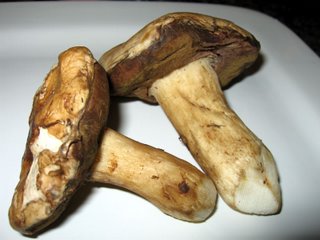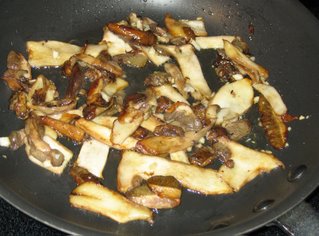The other day I was out food shopping, when I spotted a rare item not usually found adorning grocery store shelves. I had seen the dried variety before (and cooked with them several times), but this was my first face to face encounter with fresh Porcini mushrooms. If you know me at all, then you know that this meant a challenge - one that I would have to accept.
Porcini go by many other names, but the latin name Boletus Edulis tells the story (Boletus means superior mushroom). These fungi are highly regarded in many parts of the world, most notably in Italy.
I sifted through the bin and grabbed a couple of decent looking specimens. Some looked like they were a bit past their prime, but most would be just fine if used right away. I wasn't about to let my produce-pickiness get in the way of taking some of these babies home.

Ladies and gents - the king has entered the building.

A cross-section of this one reveales that familiar porcini shape.
I prefer to take a simple approach when deciding how to prepare an ingredient like this. Really this is key when it comes to cooking - when you have a great ingredient, let it be the star of the dish. I really wanted to taste the Porcini - not overpower it with other strong flavors. I decided to keep it pretty simple, sauteeing the porcini in olive oil, adding some pasta, and topping it off with a little Parmigiano Reggiano. Simple, but perfect. I wrote up the technique for you to try at the bottom of the post.
Having used dried porcini on a number of occasions, I was really curious how the fresh ones would compare. I didn't have to wait long to find out - when the mushrooms first hit the hot oil, this incredible aroma was released. It was not the familiar earthy smell of the dried porcini, but something much more delicate and intriguing.
The mushrooms were absorbing the oil and turning a nice golden color. When the pasta was ready, I tossed in the sautee and some Parmigiano. Time to taste.
Flavor wise, the fresh porcini had the same general taste as the dried ones. However, I think the earthiness tends to be a little more concentrated in dried form - I prefered the mellowness of the fresh variety. Also, the texture of the fresh was softer and meatier - also a plus. But the biggest difference I noticed was in the aroma. Each forkfull that ascended to my face brought this permeating wave of olfactory sensation, reminding me of the captivating scent of the mushroom's cousin - truffles. This aspect alone makes fresh porcini the hands down winners.
As I mentioned already, finding these in your local market may be tough. But if you dig mushrooms, searching these out is well worth the effort.
Pasta with Porcini and Parmigiano
 | For each person: |
Generously salt pasta water and bring to a boil. Heat about 1/4c of olive oil over medium heat. When the oil is hot, add the porcini and give them a quick toss in the pan. At this time, also add the pasta to the boiling water. The pasta should take about 7-8 minutes - remember, pasta never waits for it's toppings!
Give the mushrooms a toss every couple of minutes. They should start to become slightly golden. For the last minute of the sautee, add the garlic.
When the pasta is done (al dente), drain and add to the mushroom pan. Toss to coat pasta in the oil, adding more if necessary. Grate plenty of Parmigiano on top and server right away.
Notes: You can use dried porcini if fresh aren't available. Simply reconstitute them with some hot water and let them steep for 10 minutes or so. Then use them like the fresh ones.
This works well with other mushrooms too. I would stay away from the common white button mushrooms for this dish though - the mushroominess (nice word, huh?) is just a little too strong for my taste here.
I think tagliatelle or pappardelle would have been better choices for the pasta, but I didn't have any in the house. Oh well.




No comments:
Post a Comment